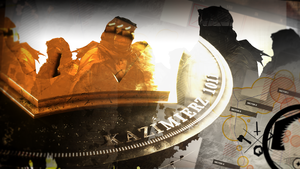Faction overview: Kazimierz
| Faction | Overview | Branches | Interactions | Gallery | Trivia |
Administration and politics
Central government
Kazimierz is de facto a confederation of feudal stratocracy. Owing to their confederate nature, a central government is established to both oversee the knight-nobles and mobilize their knight orders. In practice, the institution is a "noble's democracy" or Golden Liberty in which the aristocrats regardless of background or economy enjoy equal rights and possess extensive rights and privileges.
The central government of Kazimierz comprises three bodies: the Adeptus Sprawiedliwi Kazimierz, the National Council, and the Knights' Association. In the modern era, the Kazimierz General Chamber of Commerce is on the rise to slowly oust the Adeptus from the political circle.
Adeptus Sprawiedliwi Kazimierz
- Main article: Adeptus Sprawiedliwi Kazimierz
Kazimierz General Chamber of Commerce
- Main article: Kazimierz General Chamber of Commerce
Knights' Association
The Knights' Association is the ministry governing Kazimierzian knighthood such as peerages, knightings, and regulation on knight-nobels' activities. The history of the Knights Association is as old as Kazimierz itself which was established upon its foundation and evolution throughout history under several names. The Association has been a relatively neutral, independent ministry that stays out of the conflict between the Adeptus and the K.G.C.C., though in the modern era, the Association has shifted their focus on management of competition knights.[1]
National Council
The National Council is both the legislative and judicial body of Kazimierz. Their establishment was relatively late, originating from the Adeptus' separation of its legislative power.[1] The National Council is responsible for the establishment of new laws and amendments as well as maintaining order among the knights.
The National Council has a Chief Justice and an Associate Justice overlooking the legal process. The Policja Kazimierza nominally serves as the National Council's law enforcement.
Knights and retinues
The knights of Kazimierz are the heart of Kazimierz's stratocracy in which they are both the aristocrats governing the country and militia overlooking their soldiers. In the past, being a knight was a great honor that could grant great wealth and position, but with the rise of the capitalists, "knighthood" has become more of a commercial label to attract audiences.
There are three different kinds of knights in Kazimierz: knight-nobles, campaign knights, and competition knights, the latter of which came later in history but possessing greater influence onto the public.
An organization of knights can be divided into two groups: a smaller "knightclub" or "Club" and a larger "Knight Order." If a club achieves greater accomplishment, it will be promoted into an order, though it must also maintain its status quo to prevent itself from demotion.[2] Nowadays, they are even specifically divided into "competition knight club/order" and "campaign knight club/order" through their differences in their role.
Knight-nobles
A knight-noble or noble knight is the highest rank of the Kazimierzian knighthood. They are the traditional knights who possess a fiefdom and a large amount of properties. In the past before the founding of the Adeptus and the Knights Association, the knight-nobles were also direct leaders of their respective orders of chivalry who were responsible to mobilize their armies in war time. But since the modern era, they are forbidden to own a private army, and their activities are strictly regulated by the Knights Association, forcing the knight-nobles to focus more on economic activities such as investments and headhunting to preserve their social status.[3]
Knight families
A knight family is, as the name suggests, a hereditary family of knight-nobles. A knight family has to be recognized by both the Knights Association and the Adeptus by proving their lineage can be traced back to the ministries' foundation. And because the Kazimierian peerage does not possess hierarchical differences, every knight family is of equal rank whether in society or in the military so that all families are treated the same and carry similar responsibility in war time, limiting the power of a larger noble house. The privilege of a knight family is usually limited such as entrance to jousting events, and they lack the rights to demand their privilege's expansion.[4]
A knight family is led by a Knight Primus who is usually the head of a family. A Knight Primus has to register their name and family rank to the Knights Association to retain their title and the family's possession. Even if a Knight Primus becomes a campaign knight, they can still step in to handle their family affairs.[5] However, if a family's Knight Primus has been absent for too long, the family's status will be immediately revoked.[6]
In recent years, there is a trend of revocation of nobility onto the knight families. Many families meet their downfall because of the Knights Association's declaration of both their inability to maintain their title and the lack of a Knight Primus in a family.[5] Such action has been perceived as a silent removal of the traditionalist aristocratic class in favor of the richer capitalists.
Campaign knights
A campaign knight is a knight who dedicates his/her career and knighthood to military service under an order of chivalry. The origin of the campaign knight orders began from the Adeptus' abolishment of knight-nobles' private armies decades ago. Under the support of the Adeptus, the National Council passed a bill titled the Campaign Knights Act in which all private armies have to be under the national control of the Adeptus and that all knight-nobles are forbidden to recruit new soldiers.[7]
A campaign knight is first and foremost a soldier, then a knight. They have to temporarily freeze their social status as aristocrats until their retirement and join designated military orders under the Adeptus. Whenever internal conflict breaks out, the campaign knights have to fully obey the Adeptus' decision. Despite the strict conditions, many youths of knight families and several knight-nobles willingly join the campaign knight orders out of admiration of their highly advanced weaponry and the benefits in serving the orders.[7]
Competition knights
A competition knight is, unlike campaign knights that fully serve the military, moreso a sport athlete carrying a knighthood. Since the capitalist era, knighthood has been greatly monetized by the K.G.C.C. in which they advertise anyone could become a knight simply through registration to a sport knightclub. Bigger competition knightclubs are financially supported by corporations whereas smaller knightclubs have to support themselves.[7]
The job of a competition knight is mostly commercial. Companies running a competition knightclub have to headhunt for new recruits as well as maintaining their knights' public images. Competition knights have to actively participate in sports events such as the Kazimierz Major in which only knightclub candidates or representatives of a knight family could participate.[7] By theory, anyone could become a competition knight, whether being commoners, noblemen, or even foreigners.
Retinues
In the past, a retinue or retainer was a low-ranking servant who was tasked to overlook a knight's property whenever a military campaign occurred. During the Nightmoran invasion, the retinues formed their own alliance which would later give way to the rise of the capitalist class that eventually shared equal power with the traditionalist knights. By modern era, descendants of the retinues have become the merchants united under the K.G.C.C.[8]
Administrative divisions
Kazimierzian land is divided into territories (terytoria) which is by law the fiefdom of a knight-noble. In terms of administration, a territory is usually made up of a noble's nomadic city and the sedentary settlement surrounding the city, and sometimes a single nomadic city is a territory itself. Sedentary settlements outside of the city are usually outside of the municipal government's jurisdiction, resulting in local mayors governing the areas.[3]
Geography
Kazimierz's topography is filled with temperate grasslands and lush forests covering the hills. The grasslands of Kazimierz are suitable for large-scale agriculture; wheat and potatoes are the common crops of Kazimierzian farms. Temperature-wise, Kazimierz has a dry climate with less precipitation, cold winters and dry summers.[9]
Economy
In the modern era, the main source of Kazimierz is commercial activities and financial industries such as business investments. Kazimeirzian merchants first introduced economic study by learning from classical Victorian mercantilism and inviting Victorian economists to their country to take part of its tertiary sector. To the Victorians' surprise, even though Kazimierzian economists did not care about data analysis in their investments, they used these theories as rigid business guides, and their businesses miraculously became successful, inciting others to take part in financial activities and turning Kazimierz into the heart of economic studies on Terra.[5]
Despite the booming financial sectors, the Kazimierizian practices have resulted in several downfalls. Properties are treated as mere products for sales, and even the most valueless product could be given a value through exaggerated advertisement. Almost all Kazimierzian companies are in some ways a member of the ruling K.G.C.C., and these companies will compete against each other in similar fields. Although this is meant to encourage positive competition, Many companies use underhanded means to oust their rivals: for example, the private sector that oversees Kawalerielki's electric supply has changed to three different companies, yet the instrument and staff remain the same, which many perceived that they have been merged, or "annexed" in a classical sense, by their rivals.[5]
The extravagant capitalism also results in economic and social imbalance between the bustling cities and impoverished towns and villages in rural areas. In these sedentary settlements, agriculture is still the major economic activity in which farmers will sell a large portion of crops to representatives of the K.G.C.C. They keep contact with the outside world through tax collectors of the Adeptus and salesmen of the K.G.C.C., yet much of their infrastructure remains stagnant such as the lack of television and radio broadcasts. Furthermore, Kazimierzian villagers suffer from an imbalanced income which further discourages them to leave their settlement and travel to larger cities.[3]
Demographics
The predominant race of Kazimierz is Kuranta, many of whom descended from subjects of the Elder Pegasian dynasty ruling the area during the tribal era. The militaristic culture and strong family hierarchy of the Kuranta gave rise to the Kazimierzian knighthood in later generations.[10]
Alongside the Kuranta, other races could be found in Kazimierz such as Forte and Elafians as well as races with higher populations across other parts of Terra, i.e., Felines, Perroes, and Zalaks.
Culture
Kazimierz has long been famous for its traditional knighthood. But in the modern era, a "knight" has become more of a nominal title given to brave sports athletes. The evolution of knighthood from cruel military servants to sportsmanship is often perceived as social progression to the public, but many conservative campaign knights strongly object that the capitalization of their nobility is not only against the traditional codes of chivalry, but also brings further harm to national defense by cultivating "knights" without military capabilities.[11]
Kazimierzian knighthood gives rise to its popular jousting events. In the past, jousting was meant as trials between knights to test their skills, but the rising capitalist class have converted it into a commercial sports event.[12] To some economists, the capitalization of jousting is without consequence because these events stir excitement to the audience which in turn bring more income to the country. With the advent of nomadic cities, commercial jousting has become more common in both the bustling cities and rural areas.[11]
Kazimierz Major
- Main article: Kazimierz Major
Knights' Treasure
The "Knights' Treasures" are a series of Kazimierzian folklore narrating the lavish grave goods of a knight-noble's tomb. In the past, the knight-nobles maintained a tradition of rich funerals. Upon their deaths, their dead bodies would be buried on a specific site alongside their properties, notably expensive goods, gold coins, and advanced equipment, in hope to use them in the afterlife. As such tradition vanishes by modern era, these stories become various legends that admire a knight's chivalry and social status. However, while there are some being well-preserved, most of these tombs are lost in the advent of Catastrophes. In recent years, tomb-raiding is occurring all around Kazimierz as the stories become much more exaggerated among the bounty hunters.[13]
References
|


